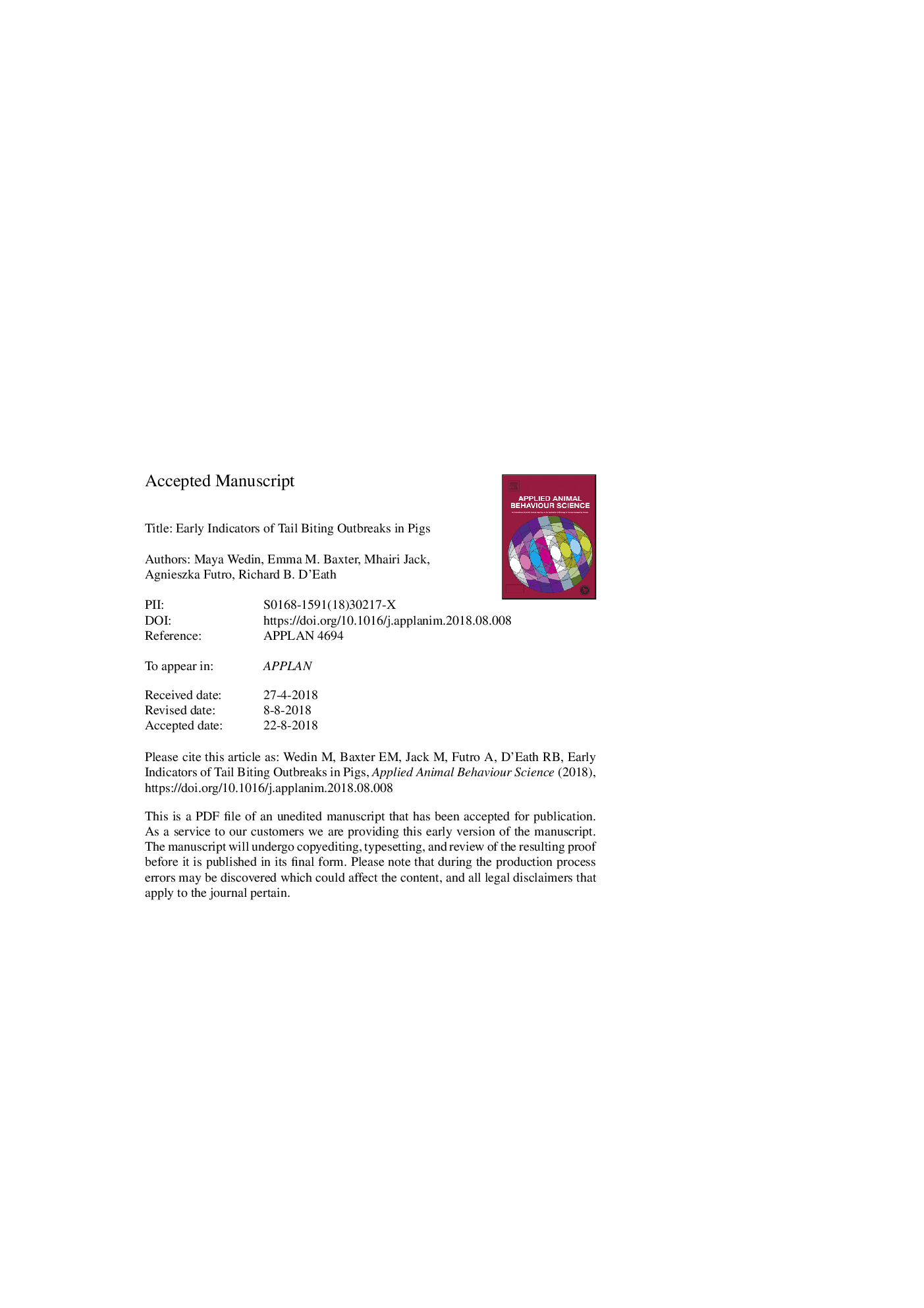| کد مقاله | کد نشریه | سال انتشار | مقاله انگلیسی | نسخه تمام متن |
|---|---|---|---|---|
| 11012973 | 1797852 | 2018 | 27 صفحه PDF | دانلود رایگان |
عنوان انگلیسی مقاله ISI
Early indicators of tail biting outbreaks in pigs
ترجمه فارسی عنوان
شاخص های اولیه شیوع بیماری های دودی در خوک ها
دانلود مقاله + سفارش ترجمه
دانلود مقاله ISI انگلیسی
رایگان برای ایرانیان
کلمات کلیدی
گزش دندان، خسارت جانی، ستون فقرات، فعالیت، شاخص ها، دم نخود،
موضوعات مرتبط
علوم زیستی و بیوفناوری
علوم کشاورزی و بیولوژیک
علوم دامی و جانورشناسی
چکیده انگلیسی
Pigs in 15 groups with a mean (±s.d.) group size of 27.5 (±2.6; 427 in total) were raised from birth under intensive commercial conditions and with tails intact. Twice daily inspections were made, and a tail biting outbreak was identified (and treated) if 3 or more pigs had fresh tail injuries, or any pig was seen with a freshly bleeding tail or vigorously biting a tail. Video footage was recorded continuously to allow pre-outbreak behaviour recording of body posture (lying laterally, lying ventrally, sitting, standing) and tail posture (curled or uncurled (high, low, tucked)). Pigs were not individually marked, thus observations were made at pen level by group scan sampling 12 times per day on day -1, -3, -5 and -7 pre-outbreak. Each outbreak group was paired with a non-outbreak group of the same age and kept at the facility at the same time which served as a control. A total of 12 pairs were used. Outbreak pigs had fewer curled tails (Pâ=â0.013) and more uncurled (Pâ=â0.008) and tucked tails (Pâ<â0.001) than control pigs overall, but particularly on day -1. Outbreak groups had more tucked tails compared to control on day -7 (Pâ=â0.001). Tail posture did not vary over days, or with time of day. Body posture was not different between outbreak and control groups, and although it was affected by time of day, there was no interaction between outbreak vs. control condition and day, or time of day. Synchrony of behaviour between pigs (more pigs in the pen showing the same body posture) was not reduced in outbreak groups. In conclusion, this study supports other recent findings showing that an increase in tucked tails, and reduced curled tails is an advance indicator of a tail biting outbreak giving at least 7 days warning, and it does not matter what time of day tails are observed. Pig farmers could take note of tail posture changes to identify high risk pens. Considerable variability between pens, and in the timing and magnitude of change means that technology to automate tail posture detection will be of benefit.
ناشر
Database: Elsevier - ScienceDirect (ساینس دایرکت)
Journal: Applied Animal Behaviour Science - Volume 208, November 2018, Pages 7-13
Journal: Applied Animal Behaviour Science - Volume 208, November 2018, Pages 7-13
نویسندگان
Maya Wedin, Emma M. Baxter, Mhairi Jack, Agnieszka Futro, Richard B. D'Eath,
